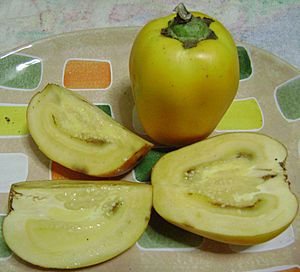Cocona facts for kids
Quick facts for kids Cocona |
|
|---|---|
 |
|
| Small cocona seedling, a few months old | |
| Scientific classification | |
| Genus: |
Solanum
|
| Species: |
sessiliflorum
|
| Synonyms | |
|
Solanum alibile R.E.Schult. |
|
The cocona (scientific name: Solanum sessiliflorum) is a cool tropical plant. It's a type of shrub that belongs to the nightshade family, just like potatoes and tomatoes!
Cocona plants have strong branches and big leaves. These leaves are often hairy and have jagged edges. The cocona plant looks a lot like its close relatives, the naranjilla and pseudolulo. But you can tell cocona apart because it doesn't have spines. Also, cocona plants usually don't have the purple color you often see on naranjilla plants.
What is Cocona?
The cocona plant grows beautiful flowers that look like big potato flowers. They have light green petals. After the flowers, the plant grows its fruit.
The fruit of the cocona is an edible berry. It can be red, orange, or yellow when it's ripe. People in parts of South America eat cocona fruit.
Where Does Cocona Grow?
Cocona is originally from the Andes Mountains region in South America. It grows naturally there. You can find it in areas around the Amazon rainforest, like the Purús Province in eastern Peru. People sometimes grow it on farms for food.
Growing Cocona Plants
Cocona plants can also be grown indoors. This is popular in places with cooler weather. However, these plants need special care. They can get tiny bugs called spider mites if the air is too dry. So, it's good to keep the air moist, especially in winter.
Like its cousin the naranjilla, cocona plants are also sensitive to aphids (small plant-eating insects) and nematodes (tiny worms).
Cocona plants like warm weather. They can handle a bit of cool air, but they don't like frost. Frost can seriously damage or even kill them. In the summer, you can grow cocona plants outside or in a cool greenhouse.
If you plant a cocona seed, you might get fruit in as little as nine months! Sometimes it can take up to two years, but it's worth the wait for this unique fruit.
See also
 In Spanish: Cocona para niños
In Spanish: Cocona para niños


